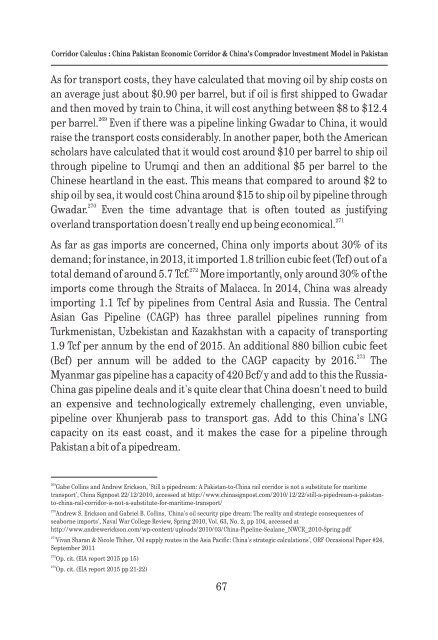Corridor Calculus
corridor-calculus-china-pakistan-economic-corridor-and-china-s-comprador-investment-model-in-pakistan
corridor-calculus-china-pakistan-economic-corridor-and-china-s-comprador-investment-model-in-pakistan
Create successful ePaper yourself
Turn your PDF publications into a flip-book with our unique Google optimized e-Paper software.
<strong>Corridor</strong> <strong>Calculus</strong> : China Pakistan Economic <strong>Corridor</strong> & China's Comprador Investment Model in Pakistan<br />
As for transport costs, they have calculated that moving oil by ship costs on<br />
an average just about $0.90 per barrel, but if oil is first shipped to Gwadar<br />
and then moved by train to China, it will cost anything between $8 to $12.4<br />
269<br />
per barrel. Even if there was a pipeline linking Gwadar to China, it would<br />
raise the transport costs considerably. In another paper, both the American<br />
scholars have calculated that it would cost around $10 per barrel to ship oil<br />
through pipeline to Urumqi and then an additional $5 per barrel to the<br />
Chinese heartland in the east. This means that compared to around $2 to<br />
ship oil by sea, it would cost China around $15 to ship oil by pipeline through<br />
270<br />
Gwadar. Even the time advantage that is often touted as justifying<br />
271<br />
overland transportation doesn't really end up being economical.<br />
As far as gas imports are concerned, China only imports about 30% of its<br />
demand; for instance, in 2013, it imported 1.8 trillion cubic feet (Tcf) out of a<br />
272<br />
total demand of around 5.7 Tcf. More importantly, only around 30% of the<br />
imports come through the Straits of Malacca. In 2014, China was already<br />
importing 1.1 Tcf by pipelines from Central Asia and Russia. The Central<br />
Asian Gas Pipeline (CAGP) has three parallel pipelines running from<br />
Turkmenistan, Uzbekistan and Kazakhstan with a capacity of transporting<br />
1.9 Tcf per annum by the end of 2015. An additional 880 billion cubic feet<br />
273<br />
(Bcf) per annum will be added to the CAGP capacity by 2016. The<br />
Myanmar gas pipeline has a capacity of 420 Bcf/y and add to this the Russia-<br />
China gas pipeline deals and it's quite clear that China doesn't need to build<br />
an expensive and technologically extremely challenging, even unviable,<br />
pipeline over Khunjerab pass to transport gas. Add to this China's LNG<br />
capacity on its east coast, and it makes the case for a pipeline through<br />
Pakistan a bit of a pipedream.<br />
269<br />
Gabe Collins and Andrew Erickson, 'Still a pipedream: A Pakistan-to-China rail corridor is not a substitute for maritime<br />
transport', China Signpost 22/12/2010, accessed at http://www.chinasignpost.com/2010/12/22/still-a-pipedream-a-pakistanto-china-rail-corridor-is-not-a-substitute-for-maritime-transport/<br />
270<br />
Andrew S. Erickson and Gabriel B. Collins, 'China's oil security pipe dream: The reality and strategic consequences of<br />
seaborne imports', Naval War College Review, Spring 2010, Vol. 63, No. 2, pp 104, accessed at<br />
http://www.andrewerickson.com/wp-content/uploads/2010/03/China-Pipeline-Sealane_NWCR_2010-Spring.pdf<br />
271<br />
Vivan Sharan & Nicole Thiher, 'Oil supply routes in the Asia Pacific: China's strategic calculations', ORF Occasional Paper #24,<br />
September 2011<br />
272<br />
Op. cit. (EIA report 2015 pp 15)<br />
273<br />
Op. cit. (EIA report 2015 pp 21-22)<br />
67


